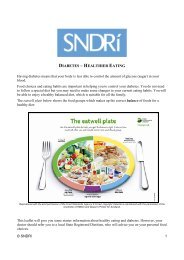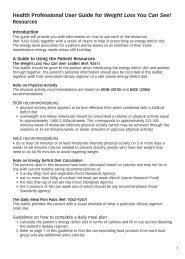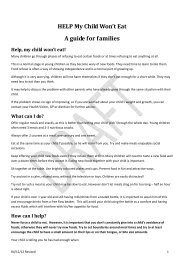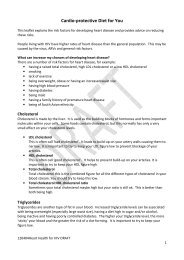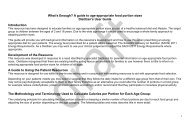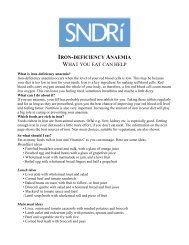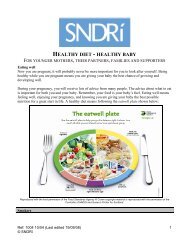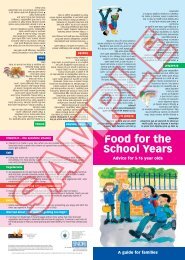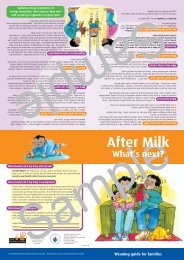9225Introduction to CHOCounting.pdf - NDR-UK
9225Introduction to CHOCounting.pdf - NDR-UK
9225Introduction to CHOCounting.pdf - NDR-UK
You also want an ePaper? Increase the reach of your titles
YUMPU automatically turns print PDFs into web optimized ePapers that Google loves.
4 . Multiply your portion by the amount of carbohydrate in 1g of Instant porridge.<br />
40 x 0.58 = 23.2g of CHO in your portion<br />
5 . Check the label <strong>to</strong> find out how much CHO is in 100ml of milk.<br />
5g CHO per 100ml<br />
6 . Measure your portion <strong>to</strong> find out how much milk you’re going <strong>to</strong> have.<br />
2 5 0 m l<br />
7 . Work out how much CHO is in 1ml of milk.<br />
5 ÷ 100 = 0.05ml in 1ml of milk<br />
8 . How much CHO is in your portion?<br />
0.05 x 250 = 12.5g CHO in your portion of milk<br />
9 . Add both amounts <strong>to</strong>gether <strong>to</strong> find how much carbohydrate is in your portion of Instant<br />
porridge made with milk.<br />
23.2 + 12.5 = 35.7g CHO al<strong>to</strong>gether<br />
Using uncooked and cooked weights<br />
Some food's weight changes significantly when it is cooked. Foods with starchy<br />
carbohydrates like pasta, rice, pota<strong>to</strong>es n o o d l e s, couscous and pulses all have different<br />
uncooked and cooked weights. This is due <strong>to</strong> the amount of water they absorb or lose<br />
during cooking.<br />
For example:<br />
• Pasta absorbs water when it is cooked.<br />
This means a portion of cooked pasta is<br />
heavier than its dried weight.<br />
• Baking pota<strong>to</strong>es causes them <strong>to</strong> lose water.<br />
This means that a baked pota<strong>to</strong> is lighter<br />
than it was when it was ra w.<br />
When you calculate the carbohydrate in these starchy foods, it is very important that you use<br />
the correct weight and c a r b o h y d rate value in your calculation.<br />
C a r b o h y d rate values for foods can vary by bra n d , cooking method and time. Always try <strong>to</strong><br />
follow cooking instructions and carbohydrate values on foods labels. If this is not possible, u s e<br />
the average values from Carbohydrate Ta b l e s or other reference books.<br />
00 12





